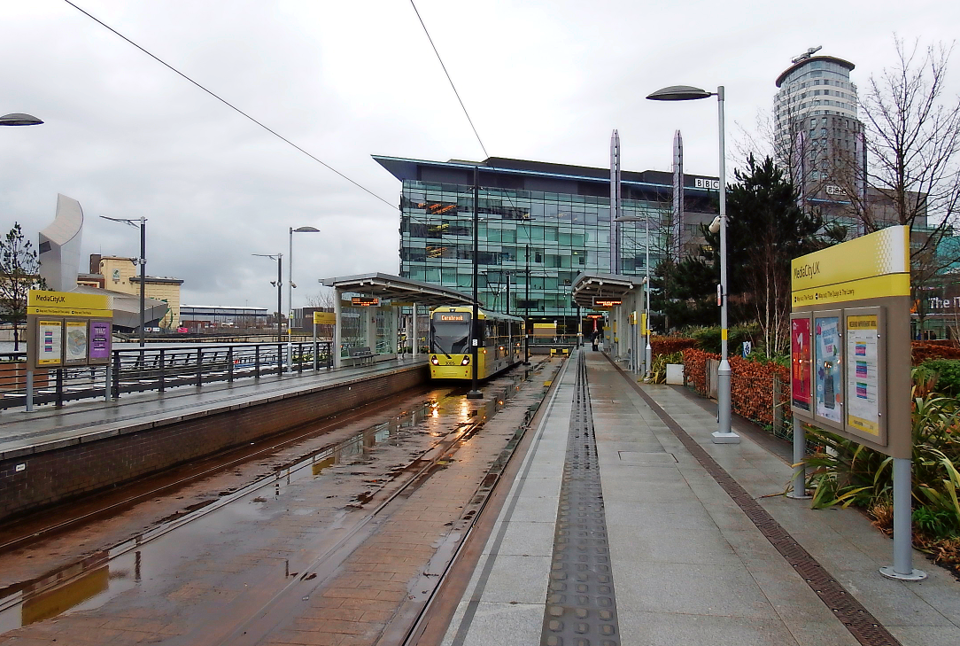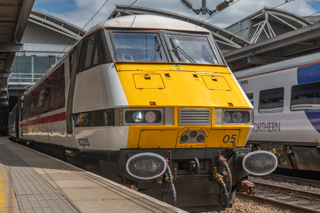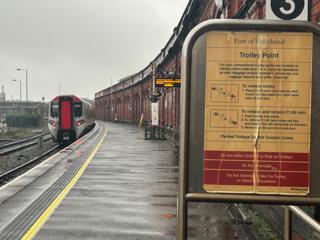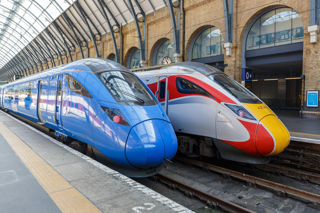Anyone who has visited Manchester over the past few years cannot fail to have noticed the huge expansion programme taking place on the city’s pioneering tramway, Metrolink. Owned by Transport for Greater Manchester (TfGM), the system has tripled in size over the past six years, making Metrolink the largest tramway in the UK.
Having decided against building the Picc-Vic (Piccadilly-Victoria) tunnel in the 1970s, due to the high costs of tunnelling beneath the city streets, transport planners in Manchester began work on what would become the first second-generation tramway to be built in the UK, trams having fallen out of fashion during the mid-20th century. Indeed, Manchester had an extensive tramway network around the city before it was closed in 1949.
Metrolink celebrates its 25th anniversary in April 2017, and the ‘new’ tramway has been through quite a journey over the past quarter-of-a-century.
The first phase between Bury, Manchester Piccadilly and Altrincham opened in stages between April and July 1992. Phase 1 entailed the conversion of two popular British Rail commuter lines (Bury to Victoria and Manchester Piccadilly to Altrincham), for operation of Metrolink’s new fleet of 26 Italian-built Firema T68 light rail vehicles (trams - numbered 1001-1026). The two lines were linked by a section of street running tramway through the city centre streets.
Both BR lines chosen for conversion to Metrolink Phase 1 were selected due to having elderly rolling stock in need of replacement, and in the case of the Bury line a unique but outdated and costly to maintain 1,200v DC side-contact third rail electrification system.
Metrolink proved to be incredibly popular. After just a few months’ service, frequencies had to be increased to cope with demand - especially during the day between the morning and afternoon peak periods, which had traditionally been much quieter during BR operations.
Indeed, daytime demand for Metrolink was almost as high as the commuter peak periods, and a six-minute core service was soon in operation from 0700 through to 2000. Outside of the peak service, trams were operated to a 12-minute frequency.
Other benefits of the modern tramway included fully accessible trams, stations (known as tramstops) and platforms, making it suitable for users who had previously found it difficult to use the BR services.
Phase 2 of Metrolink’s development was construction of a new line through Salford Quays to Eccles seven years later. This deviated from the Altrincham line at Cornbrook junction (a new tramstop was also built at Cornbrook, which hadn’t existed when Phase 1 had opened in 1992, to serve as an interchange facility). The first part of the Eccles line, through Salford Quays to Broadway, opened in December 1999. The second section to Eccles was completed seven months later.
Six new Ansaldo T68A trams (numbered 2001-2006) were purchased for use on the new line, although these were only sufficient for the basic 12-minute service frequency, which required all six trams to be in use every day. This did not provide any spare capacity for trams being out of service for maintenance or repairs, and so the operator of Metrolink subsequently modified three of the original T68 trams (1005, 1010 and 1015) to enable these to be used to supplement the T68A fleet when required, especially as reliability of the new T68A trams was poor when they were first introduced.
Greater Manchester Passenger Transport Executive (GMPTE - now TfGM), decided to seek Government funding for further expansion of the tramway. GMPTE proposed a series of new lines to make Metrolink a true transport network, with the Phase 3 expansion to be promoted as the Metrolink ‘Big Bang’.
Under the proposals the existing ‘Oldham Loop’ line between Manchester Victoria and Rochdale would be converted for Metrolink services, with a diversion to the line running through Oldham town centre (removing the section of line between Oldham Werneth, and through two tunnels to Oldham Mumps).
Meanwhile, at Rochdale the line would leave the railway formation at Newbold, running alongside Network Rail lines into a new stop built adjacent to Rochdale railway station, before a short extension would take the tramway into Rochdale Town Centre to link with the shopping facilities and the town’s bus station.
Phase 3 would also include a brand new line from Manchester Piccadilly to Ashton-under-Lyne (via Droylsden), bringing Metrolink services to East Manchester, with a large proportion of the Ashton-under-Lyne route running on-street.
This line would also serve the Sport City developments that had been built for the 2002 Manchester Commonwealth Games - the cycling Velodrome and a large football stadium (now the Etihad Stadium - the new home of Manchester City Football Club).
In the mid-1980s, GMPTE had bought from BR the derelict railway land between Trafford Bar and East Didsbury (formerly part of the Midland Main Line out of Manchester), with the aim of reopening the route for Metrolink services at a future date.
While BR was happy to offload the land and the liabilities of maintaining the structures on the route, this proved to be a shrewd move by GMPTE. The trackbed had been secured for possible future use, without the risk of land being sold off on a piecemeal basis for further developments that could have encroached on the trackbed and potentially jeopardised the reinstatement of the line.
The smallest proposed route under the Phase 3 expansion was an extension to the Eccles line between Harbour City and Broadway, featuring a quarter-mile single line installed between Harbour City and MediaCityUK.
The MediaCityUK development was being constructed by the Peel Holdings Group, and would become the main northern headquarters of the BBC along with ITV and a number of other large media organisations. The development was designed to bring a host of media companies to one central area in Salford Quays, and the construction of the Metrolink line into the heart of the development would provide a high-quality direct transport link from Manchester to the MediaCityUK piazza.
The largest single proposed route under the ‘Big Bang’ was another brand new line from St Werburgh’s Road to Manchester Airport, running through Northern Moor, Benchill and Wythenshawe. While Manchester Airport was already served by a good rail service, the route of the Metrolink line was designed to serve many of the large housing developments around Wythenshawe - many of the staff employed at the airport live in the areas which would be served by Metrolink services, giving an alternative to local bus services.
Additionally, a second Metrolink Depot and a new Control Room would be built at Old Trafford, on derelict former industrial land adjacent to the Altrincham line, to serve the increased tram fleet that would be required. Metrolink’s original depot at Queens Road would also have its main workshop building extended, with additional stabling sidings installed for increased tram capacity.
It was certainly an ambitious project, but GMPTE had proved on several occasions that it was not afraid of ambition when it came to the development of Metrolink.
Funding approval for £520 million was subsequently forthcoming from the Labour Government, before being withdrawn at a later date as a result of rising costs during the tendering process for the construction works, when it became clear that the full project could not be delivered for the funds that had been made available.
Representations from GMPTE, which mounted a high-profile ‘Get our Metrolink back on track’ campaign, resulted in the original funding being released, although the additional funds required for the full Phase 3 works would have to be sought from other sources.
The release of the original Government funding enabled GMPTE to revise its Metrolink aspirations until such time as it could fund the full Phase 3 project, with the expansions effectively split into two sections (Phase 3A and Phase 3B). The Phase 3A works could be funded using the £520m released by the Government.
Now dubbed the ‘Little Bang’, the funding allocated by Government allowed construction work to begin on conversion of the Oldham Rochdale line, while the Ashton-under-Lyne route would be constructed from Piccadilly to Droylsden and the East Didsbury line would be built as far as St Werburgh’s Road in Chorlton. These lines would be constructed under Phase 3A, with funding to complete the remaining Phase 3B sections actively being sought by GMPTE.
The consortium appointed to manage the construction works was M-Pact Thales (MPT). The MPT consortium consisted of Laing O’Rourke, VolkerRail and Thales UK, and was responsible for the design, construction and maintenance of the new Metrolink extensions. The existing Phase 1 and Phase 2 lines were to be maintained by the Metrolink operator, but the maintenance of all of the new routes would be the responsibility of MPT.
The spur from the Eccles line to MediaCityUK was funded separately as part of the MediaCityUK development, but the construction would be managed by MPT.
To serve the new lines a total of 32 new trams would be required to operate the level of services that were being proposed.
In 2007, GMPTE had ordered eight M5000 trams from Bombardier to supplement its fleet of 26 Firema T68 and six Ansaldo T68A trams. As high-floor trams from Bombardier’s Flexity Swift design, the trams were similar to ones delivered to Cologne, and were fitted with traction equipment from Vossloh.
This initial order was placed to allow Metrolink to increase capacity on the Bury-Altrincham line, which had suffered from overcrowding for many years.
The first M5000 (numbered 3001) was delivered to Manchester on July 13 2009.
It was quickly followed by an order for another four M5000s (3009-3012) to operate the new MediaCityUK service, which was proposed to operate as a shuttle service from Cornbrook. The next order was for 28 M5000s (3013-3040) to complete the tram order for the Phase 3A lines, with GMPTE having options from Bombardier to order further trams.
In May 2009, the former Greater Manchester Integrated Transport Authority and the Association of Greater Manchester Authorities had established the £1.5 billion Greater Manchester Transport Fund - this would allow the funding of several key public transport improvements, including all of the Phase 3B construction works. The investment was funded from a combination of central government grants and £775m from a combination of borrowings to be repaid from future Metrolink net revenues.
The release of this funding would allow construction of the Oldham Town Centre and Rochdale Town Centre works to the Oldham Rochdale line, the extension of the East Manchester Line from Droylsden to Ashton-under-Lyne, while at St Werburgh’s Road the lines to East Didsbury and Manchester Airport could now also be completed.
Additionally, the funding package allowed TfGM to announce plans to build a second city crossing for Metrolink services through Manchester city centre, relieving pressure on the original city corridor as well as providing an alternative means of moving trams through the city in the event of one of the lines becoming blocked during an incident.
With funds now secured for the full Phase 3 development, a further 22 M5000 trams (3041-3062) were ordered from Bombardier to serve the lines to be constructed under the Phase 3B works.
Meanwhile, studies by TfGM (as GMPTE had by then been named) had found that as well as being much more unreliable than the new M5000 design, the original T68 trams were suffering from extensive corrosion to their solebars. Keeping them in service would require expensive repairs, as well as extensive overhauls.
The decision was taken to initially withdraw 12 of the original T68s, with the first example stood down in April 2012. It was subsequently decided that rather than overhaul the original fleet, it would be more cost-effective to replace the entire T68 and the 1999-built T68A fleets with new M5000s. Thus 32 M5000s were ordered in two batches (3063-3074 and 3075-3094) to replace the old order, taking the Bombardier orders to a total of 94 trams.
All of the Phase 3A lines opened in stages between September 2010 and February 2013, although by this time MPT was also making excellent progress on many of the Phase 3B routes. It would be only another three months before the first of the Phase 3B extensions was brought into use, with the opening of the line to East Didsbury in May 2013.
MPT has received a high amount of praise for the speed and high quality of the work it has done on the new lines. While some of the earlier lines were opened later than originally anticipated, the East Didsbury line, Ashton-under-Lyne and Oldham Town Centre sections were all opened ahead of schedule. And the Manchester Airport line opened in November 2014, an impressive 18 months ahead of its original planned opening date. The short section of the Second City Crossing from Victoria to Exchange Square was also opened a lot earlier than expected, coming into use in December 2015.
Work is now complete on the econd City Crossing between Exchange Square and St Peter’s Square, and it opened on February 26. The first test trams along the new line had operated under their own power in early December.
Services will be re-cast to operate some trams along the new line, thus freeing up capacity on the original city crossing, which is currently operating at near capacity. It is also planned that at some stage Manchester Airport services will operate through to Victoria, rather than currently terminating at Cornbrook.
But TfGM is not stopping there. A major shopping centre, the intu Trafford Centre, opened in 1998. Built by the Peel Group on mainly derelict former industrial land at Dumplington, near Trafford Park, the shopping centre is the second largest retail development in the UK and attracts thousands of visitors each week.
Initially there were fears that the Trafford Centre would take trade away from retailers in Manchester city centre and the surrounding towns, but this appears to have been negligible and in line with retail experiences across the UK. Located on land close to two junctions on the M60 motorway, the Trafford Centre has 11,500 free car parking spaces. It is also well served by local bus companies.
When the centre opened in 1998 a shuttle bus service was provided, operated by Arriva and linking the Trafford Centre with Metrolink services at Stretford station on the Altrincham line. This service continued until 2013, before being withdrawn when bus services in the area were rearranged. Other local bus services continued to serve the shopping centre from bus stops located close to Metrolink stations.
However, TfGM realised that building a new route to the Trafford Centre would allow it to operate Metrolink services directly into the shopping centre. Hopefully, this would persuade more car users to choose to take the tram when they go shopping, rather than using the already heavily-congested M60 motorway corridor.
The new line would also run through Trafford Park, which employs over 30,000 people from more than 1,300 businesses based in the area, although plans for the line to operate through to Port Salford have been put on hold for the time being.
In October 2016 TfGM was granted legal powers from Secretary of State for Transport Chris Grayling to build its new route to the Trafford Centre, following a Public Inquiry into the project. The new line will cost £350m, with the necessary funds already secured by Greater Manchester Combined Authority through an ‘earn back’ funding arrangement as part of the Greater Manchester devolution deal.
The new line will deviate from the current Metrolink Eccles line at Pomona, and will then pass under the Trafford Road Bridge, running alongside the existing promenade next to Manchester Ship Canal before joining Trafford Wharf Road.
The route will then turn onto Warren Bruce Road, and then onto Village Way up to Parkway, serving the large Trafford Park estate. It then crosses over the Bridgewater Ship Canal before turning onto Barton Dock Road, terminating outside the intu Trafford Centre. Much of the new line will operate on segregated tracks, providing a faster route than would be possible if it was built on-street.
The new three and a half-mile line will feature six new tramstops, provisionally named Wharfside, the Imperial War Museum, Village, Parkway, EventCity and the intu Trafford Centre.
Construction work on the new line will once again be managed by MPT, which already has a team of engineers highly experienced in building Metrolink routes. When the line is complete, the Metrolink network will consist of 99 tramstops.
Ten M5000 trams ordered from Bombardier (3095-3104) will serve the line. These trams had been ordered by TfGM speculatively - at the time the order was placed Government approval for the Trafford Line had not yet been secured, although plans for the route were at an advanced stage and a Public Inquiry was being held into the project. The ten trams purchased for the Trafford line are already in use on the Metrolink network, forming part of the general tram fleet.
Since this order, Government funding has allowed the purchase of a further 16 trams (3105-3120) to help enhance services and increase capacity, with all 120 M5000 trams now delivered to Manchester and in service.
There were two main objectors to the construction of the Trafford Line, Manchester United Football Club and ITV Studios.
Manchester United’s objection to the line is mainly based on the effect the line could have on the flow of crowds leaving the Old Trafford ground on match days, due to the close proximity of the running line to the football ground. Government approval for the line includes express provisions for addressing traffic flow concerns around the Wharfside tramstop.
ITV’s objection came from the producers of Coronation Street, which is now based in Salford Quays as part of the MediaCity UK media development. Production of the programme moved to a new purpose-built set in 2013, having left the previous base at the former Granada Television studios at Quay Street, on the outskirts of Manchester city centre.
The programme makers raised concerns about noise and vibration from trams causing disruption to filming schedules, with the new line also running close to where the new outdoor street set is located. They hoped that the route could be diverted away from their base.
Again, it was felt that deviating the route away from the Coronation Street studios was impractical. Grayling suggested that investigations should take place to try to reduce the noise made by the trams, especially wheel squeal when negotiating sharp bends in the line.
It is hard to imagine that TfGM will not want to continue to improve and increase the Metrolink network further in the future. No doubt it will be looking closely over the Pennines at the tram-train extension between Rotherham and Sheffield on the Stagecoach Supertram network, to see if similar tram-train-style operations could be a realistic option for some of the outlying areas of Greater Manchester in the future.
This feature was published in RAIL 822 on 11th March 2017
















Ilonlzza - 22/04/2020 11:52
Приветствую Вас дамы и господа Наша предприятие мы занимаем первое место по качеству и цене производства аква продукции в Одессе. Вас может заинтерсовать: [url=https://drive.google.com/file/d/1mq1pFhgixRuaotmr5A5IAQ0czSfRG--d/view?usp=sharing]водопады дома [/url] – сделаете Ваше помещение уютнее и привлекательнее, создаст теплую релаксирующую обстановку.